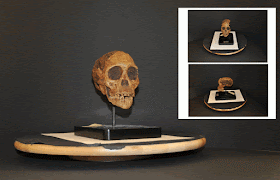This post is published very late, but, due to technical problem, I could not write it before. Among the different articles regarding the Taung Project, this one should be read at the beginning, as it regards the 3D acquisition of the cast we used for the facial reconstruction.
As usual, we tried to choose the best technique to record a 3D digital copy of our subject and, as often happened, the best strategy was to use SfM/MVSR software. Thanks to the versatility of this methodology, all I had to do was set up a makeshift photo laboratory in a free space at the Anthropological Museum of Padua University. The image below shows my temporary workspace.
 |
| The makeshift photo lab |
Then I took four different series of pictures: two for the cast of the original fossil (with and without flash) and two for a reconstructed cast of the same find (always with and without flash). I used an higher and a lower angle of shooting for each series. The animation below shows the pictures taken from the lower angle (while the two photos on the corner come from the higher corner).
As you can see, to take the pictures I used the same technique of this post. All in all, data acquiring operation did not require very much time (more or less a couple of hours) and the same day I was able to give all the photos to Alessandro Bezzi, who could elaborate them with Pierre Moulon's PPT (in ArcheOS) with his laptop (which is more fast and powerful than mine). Despite what I wrote in the post I mentioned before, this time the post-processing worked perfectly with PPT and Bundler 4, so that just some hours later a raw 3D model was ready to be sent in Brazil, where Cicero Moraes started the facial reconstruction work he described in his three posts (1, 2, 3).
Raw data
In case you want to replicate the experiment, I add some useful link to share the data. As usual in ATOR, they are licensed with Creative Commons.
Here you can download a zipped file with the original pictures. To get the 3D model you can use your favorite SfM - IBM combination of software. If everything work good, you should have a model similar to this pointcloud (you can also see in in the clip below).
If you want to give your model the real metric values, please use the A4 sheet as reference (21 x 29,7 cm), like I did for the find of this post.
Have fun!
Raw data
In case you want to replicate the experiment, I add some useful link to share the data. As usual in ATOR, they are licensed with Creative Commons.
Here you can download a zipped file with the original pictures. To get the 3D model you can use your favorite SfM - IBM combination of software. If everything work good, you should have a model similar to this pointcloud (you can also see in in the clip below).
If you want to give your model the real metric values, please use the A4 sheet as reference (21 x 29,7 cm), like I did for the find of this post.
Have fun!

No comments:
Post a Comment